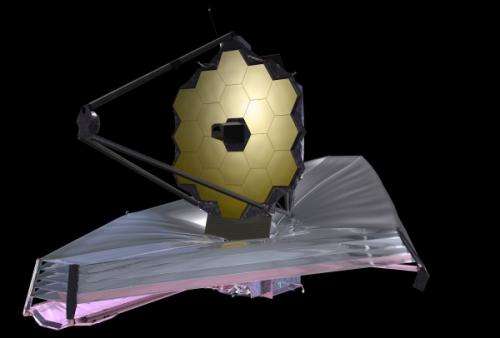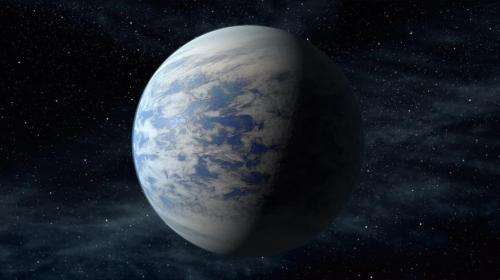Guiding our search for life on other earths

A telescope will soon allow astronomers to probe the atmosphere of Earthlike exoplanets for signs of life. To prepare, Lisa Kaltenegger and her team are modeling the atmospheric fingerprints for hundreds of potential alien worlds.
The James Webb Space Telescope, set to launch in 2018, will usher a new era in our search for life beyond Earth. With its 6.5-meter mirror, the long-awaited successor to Hubble will be large enough to detect potential biosignatures in the atmosphere of Earthlike planets orbiting nearby stars.
And we may soon find a treasure-trove of them. The forthcoming exoplanet hunter TESS (Transiting Exoplanet Survey Satellite), set to launch in 2017, will scout the entire sky for planetary systems close to ours. (The current Kepler mission focuses on more distant stars, between 600 and 3,000 light years from Earth.)
While TESS will allow for the brief detection of new planets, the larger James Webb will follow up on select candidates and provide clues about their atmospheric composition. But the work will be difficult and require a lot of telescope time.
"We're expecting to find thousands of new planets with TESS, so we'll need to select our best targets for follow-up study with the Webb telescope," says Lisa Kaltenegger, an astronomer at Cornell University and co-investigator on the TESS team.
To prepare, Kaltenegger and her team at Cornell's Institute for Pale Blue Dots are building a database of atmospheric fingerprints for hundreds of potential alien worlds. The models will then be used as "ID cards" to guide the study of exoplanet atmospheres with the Webb and other future large telescopes.
Kaltenegger described her approach in a talk for the NASA Astrobiology Institute's Director Seminar Series last December.
"For the first time in human history, we have the technology to find and characterize other worlds," she says. "And there's a lot to learn."
Detecting Life From Space
In its 1990 flyby of Earth, the Galileo spacecraft took a spectrum of sunlight filtered through our planet's atmosphere. In a 1993 paper in the journal Nature, astronomer Carl Sagan analyzed that data and found a large amount of oxygen together with methane—a telltale sign of life on Earth. These observations established a control experiment for the search of extraterrestrial life by modern spacecraft.

"The spectrum of a planet is like a chemical fingerprint," Kaltenegger says. "This gives us the key to explore alien worlds light years away."
Current telescopes have picked up the spectra of giant, Jupiter-like exoplanets. But the telescopes are not large enough to do so for smaller, Earth-like worlds. The James Webb telescope will be our first shot at studying the atmospheres of these potentially habitable worlds.
Some forthcoming ground-based telescopes—including the Giant Magellan Telescope (GMT), planned for completion in 2020, and the European Extremely Large Telescope (E-ELT), scheduled for first light in 2024—may also be able to contribute to that task.
And with the expected discovery by TESS of thousands of nearby exoplanets, the James Webb and other large telescopes will have plenty of potential targets to study. Another forthcoming planet hunter, the Planetary Transits and Oscillations of stars (PLATO), a planned European Space Agency mission scheduled for launch around 2022-2024, will contribute even more candidates.
However, observation time for follow-up studies will be costly and limited.
"It will take hundreds of hours of observation to see atmospheric signatures with the Webb telescope," Kaltenegger says. "So we'll have to pick our targets carefully."
Discover the latest in science, tech, and space with over 100,000 subscribers who rely on Phys.org for daily insights. Sign up for our free newsletter and get updates on breakthroughs, innovations, and research that matter—daily or weekly.
Getting a Head Start
To guide that process, Kaltenegger and her team are putting together a database of atmospheric fingerprints of potential alien worlds. "The models are tools that can teach us how to observe and help us prioritize targets," she says.

To start, they have modeled the chemical fingerprint of Earth over geological time. Our planet's atmosphere has evolved over time, with different life forms producing and consuming various gases. These models may give astronomers some insight into a planet's evolutionary stage.
Other models take into consideration the effects of a host of factors on the chemical signatures—including water, clouds, atmospheric thickness, geological cycles, brightness of the parent star, and even the presence of different extremophiles.
"It's important to do this wide range of modeling right now," Kaltenegger said, "so we're not too startled if we detect something unexpected. A wide parameter space can allow us to figure out if we might have a combination of these environments."
She added: "It can also help us refine our modeling as fast as possible, and decide if more measurements are needed while the telescope is still in space. It's basically a stepping-stone, so we don't have to wait until we get our first measurements to understand what we are seeing. Still, we'll likely find things we never thought about in the first place."
A New Research Center
The spectral database is one of the main projects undertaken at the Institute for Pale Blue Dots, a new interdisciplinary research center founded in 2014 by Kaltenegger. The official inauguration will be held on May 9, 2015.
"The crux of the institute is the characterization of rocky, Earth-like planets in the habitable zone of nearby stars," Kaltenergger said. "It's a very interdisciplinary effort with people from astronomy, geology, atmospheric modeling, and hopefully biology."
She added: "One of the goal is to better understand what makes a planet a life-friendly habitat, and how we can detect that from light years away. We're on the verge of discovering other pale blue dots. And with Sagan's legacy, Cornell University is a really great home for an institute like that."
Journal information: Nature
Source: Astrobio.net
This story is republished courtesy of NASA's Astrobiology Magazine. Explore the Earth and beyond at www.astrobio.net .





















